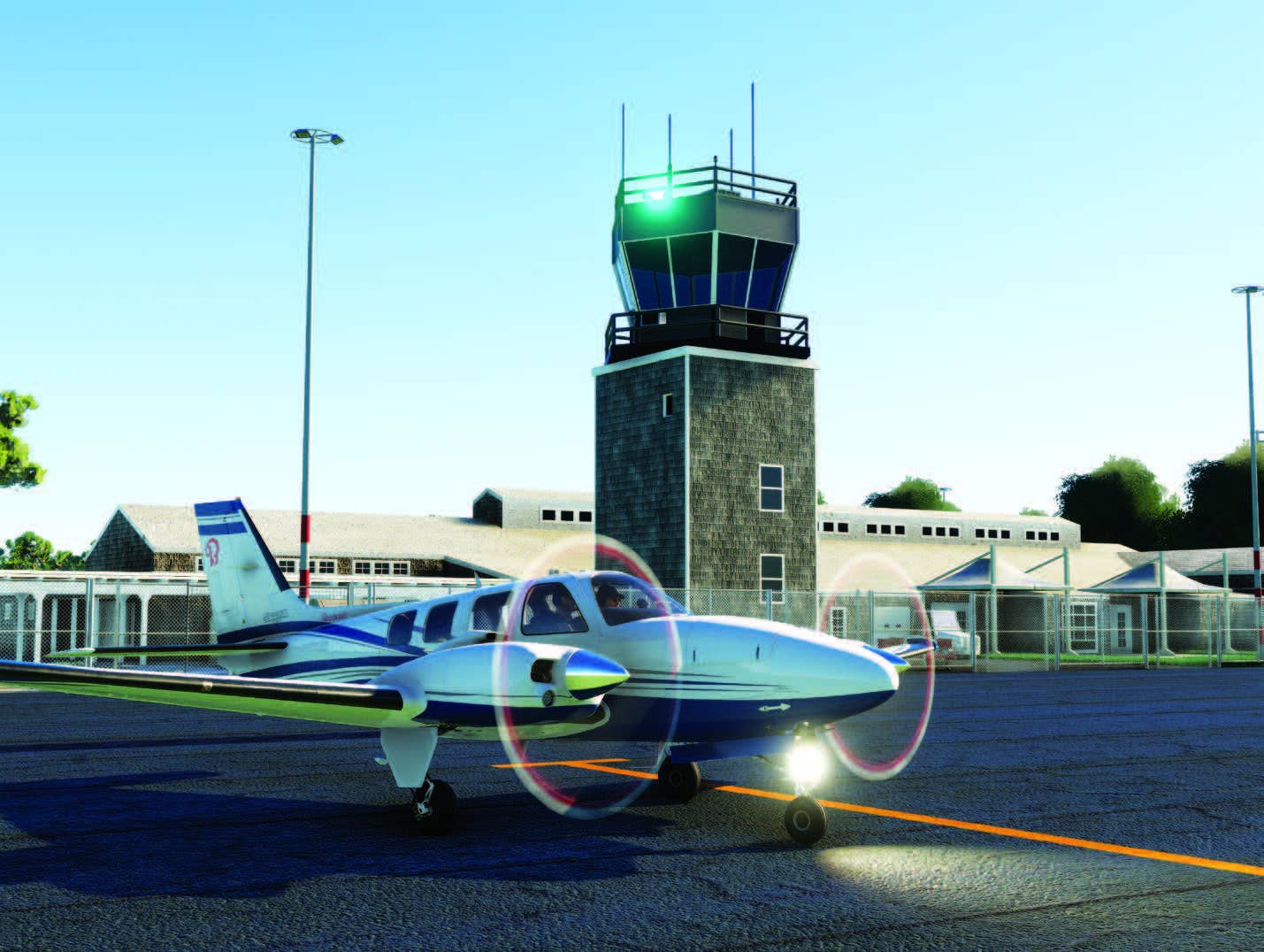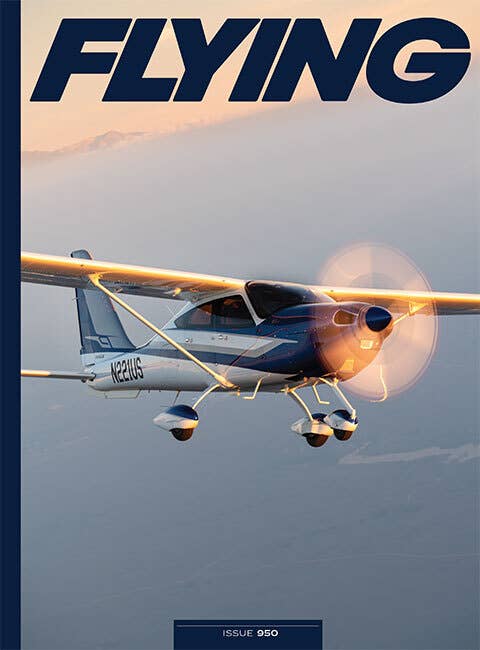After my previous two FLYING articles focusing on optional hardware improvements to your home simulator, I received correspondence from readers that prompted me to write on the topic of what non-hardware improvements you can make to your sim to deepen your immersion and learning. Over the course of this and my next few articles, I’ll cover some budget-friendly next steps that you can take to help get the most out of your home flight sim cockpit.
For me, each one of these add-ons to my simulator has enhanced my experience significantly, allowed me to learn more about real-world flying, and brought me deeper into the hobby. And compared to hardware upgrades, the following suggestions have relatively low cost or no cost. Also, they can be added to your simulator at any time, regardless of where you are in the build or improvement process.
If you’re not already a subscriber, what are you waiting for? Subscribe today to get the issue as soon as it is released in either Print or Digital formats.
Adding a Live ATC Service
When I’ve shared my interest in home flight simulation with real-world pilots over the last few years, I’m surprised at how few have heard of live ATC services and how much they expose the sim pilot to compelling at-home learning experiences. If you’re like me and use your own sim for real-world flying skills practice, or if you desire to go back to real-world flying someday, you should try one of the following options for integrating live ATC service.
There are three leading options available to the worldwide community of flight sim enthusiasts. They are the Virtual Air Traffic Simulation Network (VATSIM, which provides live ATC coverage of major airspace regions around the world), International Virtual Aviation Organization (IVAO, used mostly in Europe), and PilotEdge (a paid service that provides ATC coverage of the Western U.S. and ZLA (Los Angeles Basin) only. In this article, I will provide an overview of my experience with VATSIM and PilotEdge, omitting IVAO as I have never used it but understand it to be similar to VATSIM.
VATSIM
To decide which live ATC service is right for you, it is important to understand the differences between VATSIM and PilotEdge. With VATSIM, it’s provided by ARTCC regions, much like the organization of the national airspace system in the U.S. VATSIM USA is broken into the same ARTCC regions, and a VATSIM member can choose the region they want to fly in at any given time.
Although live ATC is not provided on a daily repeating schedule, each region chooses when the service is going to be provided. The Boston Virtual ARTCC (BVARTCC) that I fly in tries to publish the controller availability a few days to a week in advance, but coverage can vary widely, with volunteer controllers available on most weeknights and weekends. BVARTCC updates its Discord channel with controller availability, providing notifications to members when a volunteer controller begins service.
The controllers who serve the VATSIM community have gone through the required self-paced learning modules, built with input from real-world controllers, and have practiced, apprenticed, and worked their way up through the controller rating system to develop the communication skill set to serve the VATSIM pilot community. Back in the early 2000s when VATSIM was founded, enthusiasts were able to simulate the role of professional controllers. It was informal at first, but it has since grown into a professionally run global network of volunteer controllers serious about developing their craft. Becoming a VATSIM controller takes time and dedication, similar to what is required for real-world pilot ratings.
Amazingly, VATSIM is a free service provided by the controllers to all VATSIM pilots, all without compensation for their time and effort. You read that correctly: After hours and hours of training and mentorship, a volunteer controller can move into controlling some of the busiest digital airspace in the world of flight simulation, and there is no compensation for their efforts. There is certainly gratitude provided by conscientious sim pilots who praise the controllers as their shifts end. It is usually well-earned, especially when a VATSIM controller has to empty their tank of patience on a pilot who doesn’t come prepared for the demands of their aircraft and chosen flight plan.
One downside to the VATSIM service is that it only takes one unprepared pilot who’s not ready to manage their aircraft to stack up an airspace or monopolize a controller’s time at the expense of providing equal coverage for all participants. This happens because sometimes a single VATSIM controller must cover all the communication responsibilities in a given airspace, providing center, approach, and tower communications simultaneously for many aircraft at once. I have found all of VATSIM’s controllers to be talented and capable of handling the challenge of the workload on a busy weeknight or weekend afternoon when many flight sim pilots are coming into and out of a high traffic ARTCC like the Boston area (ZBW). In my experience, the Boston controllers are consistently professional, knowledgeable, and patient, making the airspace a fun environment to learn in.
I was so struck that members of the flight sim community would want to subject themselves to the challenge of working busy airspace for multiple hours for no pay that I interviewed Evan Reiter, a founding member of the Flight Simulation Association, one of the largest groups for enthusiasts in the world and the same group that organizes FlightSimExpo. In addition to his full-time job as an airline pilot in the real world, he is one of the most active controllers in the ZBW.
Last year, we met online for a quick video chat as I wanted to uncover why he spends some of his downtime between airline flights working as a controller on VATSIM. After ascending into the ranks of professional pilot, I wanted to understand what drove him back to his controlling duties on VATSIM. Reiter credits flight simulation and air traffic control on VATSIM with launching his real-world aviation career.
“I honestly don’t know that I would have gone into aviation if not for flight simulation or VATSIM,” Reiter said. “My parents are lawyers and nobody in my family has anything to do with flying.”
Reiter and many controllers like him spend time paying it forward to the next generation of flight sim enthusiasts in the VATSIM community because of what it has helped them achieve.
Since a laptop and headset are all that is needed to be a controller in VATSIM, sometimes Reiter breaks up the monotony of his nights on the road with the airline to control online from his hotel room for a few hours. Because of the commitment of Reiter and the many controllers around the world volunteering their time, VATSIM remains a dynamic learning environment for sim pilots.
In fact, long before Reiter reached the flight deck of a real airliner, he started learning on VATSIM and taking his experiences into his real-life flight training.
“You can learn a lot in a traditional ground school program, but the resources provided by VATSIM’s controllers allow you to learn while you’re operating a digital airliner and then pull forward some of those experiences into your real-life flight training,” he said.
Personally, I have found that layering in a service like VATSIM into my flight simulation awakens the experience like nothing else. Being able to key the mic on frequency and continually practice my radio work from the comfort of my home creates a consistently high level of immersion, allowing you to get a mental workout when flying your aircraft through busy digital airspace like the ZBW.
If VATSIM controllers aren’t available in your region ARTCC, it is easy to “chase” live coverage by looking at the maps of the different regions and seeing which ones are staffed. This may require you to try flying in other airspaces, forcing you to learn the airspace and airports in your flight planning process, which reminds me of the preparation required for my real-world private pilot cross-country training flights.
Make sure you visit the VATSIM region website where you intend to fly, and take note of the various free events they host, mostly on weeknights and weekends. The BVARTCC hosts a few special events per month, with different themes, encouraging you to visit new airports in the region. All events are free to join and generally guarantee ATC coverage at specific airports in a region and at all levels from center controllers to approach and tower, and then sometimes ground controllers, all of whom have unique, individual voices, attitudes, and experience levels just like the real world.
The BVARTCC also hosts a few special events during the year like the recent 60 hours of uninterrupted live ATC service for sim pilots that stretch from the start on a Friday evening through the weekend. In August, the annual Boston Tea Party event features live air traffic controllers staffed through the evening, encouraging longer distance flights to and from Boston Logan (KBOS). Boston is also a frequent host to the annual “Cross the Pond” eastbound and westbound flights, encouraging cross-ocean sim flights to London Heathrow (EGLL), making the event truly international. If you want to fly in this special event, you’ll need to reserve your slot and be comfortable operating an airliner in your sim for the duration of the flight.
Some of my favorite memories on my flight simulator have been getting sequenced in heavy arrival traffic at night during a BVARTCC club event. Like any flight in the real-world, make sure you prepare by reading the event notes, checking the weather (flying in live weather conditions is encouraged) and loading it into the sim in an appropriate aircraft for the event. Your preparation helps make the event run smoothly for all.
Besides monthly events, the BVARTCC offers a series of its own self-guided, self-paced training flights called WINGS flights with six VFR missions and 24 IFR missions, taking you from steam-gauge, single-engine aircraft up to missions recommended for business jets or airliners. You will need to successfully complete the flight within the parameters to have the controller on duty issue you a passing mark. Having completed the six VFR missions in 2023, I’m currently still in the beginning of my WINGS instrument flights and hope to make some more progress on them this winter as they complement and help reinforce concepts that I am learning in my real-world instrument rating classwork.

PilotEdge
If the goal of your home flight sim experience is to support your efforts to obtain a new rating in the real world, or you are using it for informal at-home pilot recurrency, then PilotEdge might be the best solution for you. PilotEdge provides reliable live ATC coverage 15 hours a day, from 8 a.m. to 11 p.m. PT, seven days a week. It uses a mix of active-duty FAA air traffic controllers, retired controllers, or enthusiast controllers who have hundreds of hours (or more) of controlling experience. The PilotEdge FAQ section of its website states that you’ll be “hard-pressed to tell the difference” between the three categories of controllers that work the digital airspace. From my own personal experience on PilotEdge, I found this to be true.
PilotEdge controllers were demanding but fair, and they absolutely treated their controlling duties like they were controlling in the real world. They were both formal and serious, and I recommend you be ready for whatever airspace you plan on flying in. They do not coddle the unprepared with a lot of patience, which is very realistic, especially if it is a busy night at John Wayne (KSNA) or LAX. However, it is their adherence to strict air traffic control that makes it the most compelling and realistic experience you can have in a home flight simulator.
Unlike VATSIM, PilotEdge is a paid service, either by a monthly or annual subscription. It does offer a short free trial, so you can see if the service is right for you. The paywall keeps the service a dedicated learning environment, with far fewer unprepared pilots holding up the digital airways. The service is so complete in its replication of the real world that controllers can give out deviations to pilots who don’t follow correct procedures. How do I know about PilotEdge controller-issued pilot deviations? I am the recipient of one. I chalk it up to a valuable learning experience, having selected an aircraft that was too fast for my skill level and current instrument flight rules knowledge at that time. The controllers on PilotEdge provide a learning environment that is so realistic, they’ll have current instrument pilots on their best behavior. In short, it is a very impressive service and worth the modest monthly fee, especially if you’re trying to knock off the rust in preparation for real-world flying. They also provide ATC service to commercial clients who need their pilots in top form in real-world conditions.
Like VATSIM, PilotEdge also offers a set of self-paced, self-administered training scenarios for you to follow. I’ve written about them in previous columns in FLYING, but in summary, PilotEdge offers 11 VFR flights, called CAT flights, designed for you to study and successfully pass or fail under the watchful eye of the controller. The first CAT flights take you from pattern operations in a quiet Class D airport and slowly build your skills so you can tackle the CAT 11—a demanding Class B VFR flight from KLAX to KSAN. Then, you can begin your IFR flying with 11 I-rating flights focused on learning IFR communications and procedures. All CAT and I-rating flights take place in the Greater Los Angeles area of the ZLA. Completing all of the VFR CAT flights made me feel prepared to call for my first IFR clearance required in the I-rating 1 flight, which was a quick trip around the pattern following IFR procedures at John Wayne.
In addition, the I-rating flights will keep you busy learning or relearning the instrument procedures required to complete the flights successfully. For my first few I-rating flights, I loaded into the sim without the PilotEdge service running to practice the flight ahead of time before layering in the demands of ATC.

Choosing Between PilotEdge and VATSIM
Layering over PilotEdge or VATSIM on your home flight sim allows you to practice with a higher level of realism and immersion that just doesn’t happen without it. You can achieve the benefits of managing the task saturation of a busy departure or arrival all while flying the airplane. If you miss your altitude or heading by a wide margin and it goes uncorrected, it will draw the attention of the controllers in either service. In general, live ATC is best suited to flying into and out of controlled airspace, so it’s not for every flight sim pilot or for every mission. Sometimes I don’t use VATSIM when I prefer a more casual experience like a sightseeing flight or exploring a new destination for the first time. But once you add live ATC to your home flight sim use, the services open up a host of new activities to enrich the experience.
While the controllers on both services are professional, knowledgeable, and take the entire experience seriously, I have found VATSIM to be a slightly more relaxed environment in which to learn. To determine which service is best for you, I recommend you try both. Signing up for VATSIM is free, and be sure to try both VFR and IFR flights (if you have your real-world instrument rating). Then compare the experience to PilotEdge, completing a few CAT or I-rating flights to experience the difference in the two services.
What About AI-powered Virtual ATC Services?
Developments in the vast world of flight simulation move faster than the real world. For example, AI-powered ATC services are now available from two new companies that presented at the 2024 FlightSimExpo in June. Both SayIntentions and BeyondATC offer free trials and a monthly fee for their services. I tried the SayIntentions service in the fall and found it to be interesting, novel even, but still in its nascent stages of development.
Comparing either AI service to VATSIM and PilotEdge would not be fair, given that both AI ATC providers are not yet fully featured, and both are working hard to offer comprehensive VFR and IFR services, compared to more basic versions of those services available. Given the rapid pace of development, I plan to revisit these services once they have reached greater product maturity.
Next Steps
For me, the combination of WINGS training flights and practicing in my real-world home airspace keeps me coming back to VATSIM and my regional BVARTCC club most often. However, I will renew my PilotEdge membership again without hesitation when I’m ready to tackle the rest of the I-rating flights. If you plan on flying your simulator in the digital airspace of the United States, you can choose a club from the VATUSA homepage. You’re welcome to select any club, and don’t need to choose your own real-world airspace like I did.
In comparison, PilotEdge’s guaranteed 15 hours of daily ATC service is an attractive feature as it can be a real benefit to your home flight simulation use if you have a set time per day when you can use it. The air traffic controller service only serves the Western U.S. and Los Angeles areas, but it is a huge amount of airspace to explore. The good news is that you can be a member of both VATSIM and PilotEdge at the same time, flying on either service when it works best for you. When you are ready to proceed:
- Purchase a comfortable gaming headset with a boom mic.
- Sign up for a VATSIM membership. It’s free, just set aside some time to register and go through the basic training/tutorials.
- Try PilotEdge by signing up for a free trial at pilotedge.net/join.
No matter which service you choose, I have found no experience more captivating than talking to human air traffic controllers on the digital frequencies from my home flight simulator. I can reach realistic levels of task saturation working with the controllers who provide the foundation for the incredible scenario-based training experiences available to you in the VATSIM BVARTCC WINGS program or the PilotEdge CAT and I-Rating training flights.
Having live ATC available on my home flight simulator is an enormous value, allowing me to learn in a dynamic digital airspace, working with experienced controllers. The training flights provide realistic levels of task saturation, the live events are both challenging and fun, and the human interaction is so compelling that I don’t want to fly without it
This column first appeared in the February Issue 955 of the FLYING print edition.
Credit: flyingmag.com










